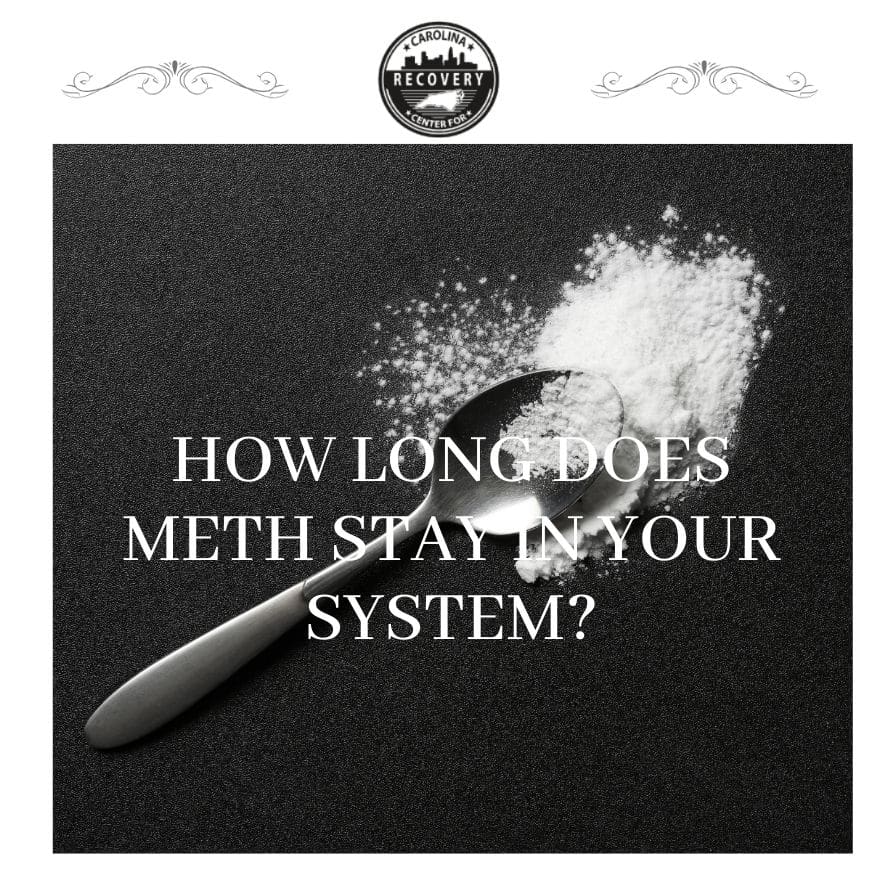How Long Does Meth Stay in Your System?

Medically Verified: 2/1/24
Medical Reviewer
Chief Editor

All of the information on this page has been reviewed and verified by a certified addiction professional.
Methamphetamine use jeopardizes the health and safety of people and their communities. People who use meth are at risk of overdose, addiction, and other severe short and long-term consequences to their mental and physical health.
People who use meth may wonder how long meth stays in your system. The answer to this question can be complicated– the effects of meth may not last as long as the consequences do, and drug testing may detect it in a person’s system long after their last use. Typically, meth can stay in a person’s system for several days after using it and can be detected by some drug testing for up to 4 days after you take it.
If you or someone in your life struggles with methamphetamine abuse or addiction, you are not alone. Contact the Carolina Center for Recovery to learn about our conference of treatment programs or to be connected to support at any stage of your recovery.
What is Meth?
Methamphetamine, also known as meth, is a potent, illicit stimulant drug. People create meth by combining common household chemicals in illegal, unregulated laboratories. Meth takes the form of a whitish, odorless crystal powder that is dissolvable in water or alcohol.
Methamphetamine was first made early in the 20th century and was derived from amphetamine. Methamphetamine was initially used for medicinal purposes, most commonly as a nasal decongestant.
Methamphetamine effects are very similar to the effects of amphetamine. However, more methamphetamine is able to reach the brain, making it a potent stimulant. The effects of methamphetamine may be longer-lasting and more dangerous than those of amphetamine. It is also more likely to be abused, leading to dependence and addiction.
The Effects of Meth
Abusing methamphetamine can lead to serious short and long-term damage to your physical health and emotional well-being.
Short-term effects of meth include:
- Rapid heart rate
- Increased blood pressure and respiration
- Insomnia
- Anxiety
- Paranoia
- Elevated body temperature
- Aggressive or violent behaviors
- Stroke
- Heart attack
- Tremors
- Seizures
Some of meth’s most dangerous effects can occur after just one use. The risk of dangerous complications increases when people use it with other substances, including other illicit drugs, prescription medications, and alcohol.
The long-term effects of meth abuse include:
- Depression
- Paranoia
- Confusion
- Aggression
- Hallucinations
- Brain damage
- Cardiovascular problems
- Increased risk of HIV/AIDS, hepatitis B and hepatitis C
- Changes to physical appearance, including thinning hair, skin sores, tooth decay, and significant weight loss
People who misuse methamphetamine require comprehensive addiction treatment and ongoing support to avoid relapse.
How is Meth Metabolized?
Meth is primarily metabolized through a process called hepatic metabolism, in which enzymes in the liver chemically alter meth molecules to make them more water-soluble, aiding in their excretion from the body.
Methamphetamine is transformed into various metabolites during this process. The primary metabolite is amphetamine, which is also an active compound and contributes to the drug’s effects. Other metabolites include p-OH-methamphetamine and p-OH-amphetamine. The water-soluble metabolites are then excreted from the body primarily through urine.
Meth has a relatively long half-life, which means it remains in the body for an extended period, contributing to its prolonged effects and potential for abuse. The half-life of methamphetamine can vary depending on the specific form of the drug (e.g., the street drug meth) and individual factors, such as metabolism and the presence of other substances in the body. However, in general, the half-life of methamphetamine is estimated to be approximately 10 to 12 hours when taken orally.
This means that, on average, it takes about 10 to 12 hours for half of the ingested methamphetamine to be eliminated from the body. However, it’s important to note that the effects of methamphetamine can last much longer than its half-life, especially when the drug is abused in higher doses or in a more potent form, such as crystal meth. The effects of meth can persist for hours or even days, leading to a high potential for abuse and addiction.
Understanding How Long Meth Stays in Your System
The effects of methamphetamine typically last between 8 and 24 hours, depending on how people use it. However, drug screening tests can detect meth throughout the body’s systems.
Here are some guidelines for how long meth stays in your system and may be detectable through drug screening.
Urine
Urine tests can typically detect meth for up to 3 days after you last use it. However, urine tests may be able to detect methamphetamine for several days longer and people who use it heavily or those who have a long history of meth abuse.
Blood
Blood tests are typically more sensitive and effective at detecting meth throughout the body than urine tests. A blood test can normally detect methamphetamine up to 4 days after a person’s last use, although certain factors can change how long the drug is detectable.
Saliva
Saliva tests have a similar sensitivity rate to blood tests and can usually detect meth for up to 4 days after a person last uses it.
Hair
Hair tests can typically detect meth use for long periods–- as much as 90 days in some cases. While hair testing is not commonly used for workplace drug screening, it can be helpful in research or forensic testing.
Testing positive for methamphetamine means you need help to safely stop using the drug and regain control over your substance use. It is essential to seek treatment as soon as you recognize substance abuse.
What Factors Affect How Long Meth Stays in Your System?
Several factors can affect how long meth stays in your system.
Frequency of use
Regular or heavy methamphetamine users are more likely to have longer periods where meth is detectable in their systems.
Body composition
Weight, body fat percentage, and muscle mass can affect how long meth is detectable in your system.
Age
Age can play a significant role and how long meth stays in your system. Older people tend to have lower metabolisms, which can slow down the rate at which the body eliminates meth.
Kidney and liver health
Poor kidney and liver health can affect how long meth stays in your system. People with impaired kidney and liver functioning may have higher levels of meth in the body, and it may be detectable for longer periods.
Other substances used
Using other substances, including other drugs and alcohol, can speed up or slow the rate at which methamphetamine is metabolized.
There is no safe way to speed up the rate at which your body eliminates methamphetamine. Worrying about how long meth stays in your system may indicate that you need professional substance abuse treatment.
Find Meth Abuse Treatment Now
If you or someone in your life requires treatment for methamphetamine abuse or addiction, you are not alone. Reach out to the Carolinas Center for Recovery now to learn about our effective, comprehensive meth rehab programs in North Carolina. Don’t wait another day for the help you need. Call now to get started.

